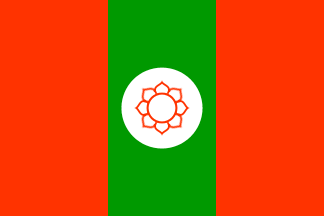 |
 |
 |
|
History
NOMENCLATURE ´Madhesh´ is a morphological derivative of Madhyadesh (Sanskrit) or Majjhimadesh (Pali) and means the Middle Country signifying its location in the middle of the Indian Subcontinent. Terai (also written as Tarai) is presumed to be derived from Persian, meaning “damp”, and denotes the land at the foothills of mountains, often damp and swampy (Gaige 1975: Regionalism and National Unity in Nepal, pp.2, University of California Press). Madhesh and Terai, both have been in use indiscriminately and synonymously in general context, in present day Nepal, however, the former includes the connotation of identity and culture of people living in the region, whereas the latter refers to geographical feature or terrain characteristics of the region. The use of Terai was popularised during Nepali colonisation. Madheshis are residents of Madhesh sharing the correlated regional, cultural and lingual space.
VEDIC PERIOD The nation of Madhesh (Madhyadesh) exists since the beginning of human civilisation on the Indian Subcontinent. Vedas, Puranas, and other ancient texts have abundant descriptions of Madhyadesh. The boundary of Madhyadesh is defined in ancient texts of Vedic era. For example, Manusmirti (circa 1500 BC, 2/21) defines Madhyadesh as the land between Himvat (Himalaya) and Vindhya Mountains and to the east of the river Vinasana (invisible Saraswati) and to the west of Prayag. According to the Vedic Civilization, the first significant king of Madhyadesh is said to be Ikshyaku or Okkāka, the son of Vaivasvata Manu and grandson of Vivaswan. Thirtyfour dynasties after him comes the much celebrated generation of Ram, and Sita, the daughter of King Janak whose capital is said to be at the current town of Janakpur in Madhesh. The descriptions of various ruling dynasties can be found in the ancient texts such as Purana, Mahabharat and various Smiritis.
500 BC – 1400 AD Around 500 BC, at the time of Buddha, the Buddhist texts calls this ´Middle Country´ Majjhimadesh in Pali language and defines the region in canonical texts Vinaya Pitaka as extended “in the east to the town of Kajangala, beyond which was Mahāsāla; on the south-east to the river Salalavatī; on the south west to the town of Satakannika; on the west to the Brahmin village of Thūna; on the north to the Usiraddhaja Mountain.” At the time of Buddha, the eastern limit of the Middle Country had extended nearly 400 miles eastward of Prayaga which was its eastern most point in the Manu’s time (Bhandarkar, 1918). According to Pali canon, the Majjhimadesh was “three hundred yojanas in length, two hundred and fifty in breadth, and nine hundred in circumference” and it contained fourteen out of the sixteen Mahājanapadas (Kāsī, Kosala, Anga, Magadha, Vajji, Mallā, Cetiya, Vamsā, Kuru, Pañcāla, Macchā, Sūrasena, Assaka, Avantī). Madhesh was ruled by several great dynasties in ancient and medieval times, from Emperor Ashoka to King Salhesh (c.500-600AD) and Harisinghadev (c. 1300AD).
MUSLIM RULERS, BRITISH EMPIRE AND SEN KINGS (1300 AD – 1800 AD) Upon the arrival of Islamic rulers from the Mid East on the Indian Subcontinent, they also called the plains of “undulating former marshland” of the Middle Country as ´Terai´, a word derived from Persian (तराई / ترائی ´wetland´ from تر ´wet´ ), meaning “moist land” (Encyclopedia Britannica). The British missionaries and the East India Company who came after Mughals also refer this region of Madhyadesh with this name or its variants. However they also continued to use Madhyades as well, for example, see Martin (1838), Elliot (1849), Muir (1873). In 1325 AD, during the reign of Harisinghadev, Sultan Gayasudhin Tuglak attacked to the capital then at Simaraunagadh and destroyed it. Madhesh became part of Mughal Empire, after that, came under the East India Company. At the later stage of British Raj, the northern part of Madhyadesh was ruled by Sen dynasty as suzerainty states and paid taxes to Nawabs and the East India Company.
UNDER NEPALESE/GURKHA EMPIRE ( 1800 AD – ) With the state expansion initiated by Gurkha ruler Prithvi Narayan Shah in the late 18th century, Gurkhas conquered some parts of the Madhesh (Madhyadesh) and took many from Nawabs and the East India Company by paying tax or through treaties. The part of Madhesh present today in Nepal is a result of memorandum of 1816 and treaty of 1860 with the East India Company. Through the memorandum of 8 December 1816, the Company government handed the region between west of Koshi and east to Rapti river to Nepal instead of paying two hundred thousands rupees per year as agreed previously on Gurkhas´ request for supporting living cost of their employees. The region west of Rapti and east of Mahakali came through the treaty of 1860 as a reward to Gurkhas for their support to the East India Company for suppressing Sepoy Mutiny of 1857 to 1859 and is also called Naya Muluk (New Region). In the Anglo-Gurkha war of 1814-16, the Madheshis had fought for the British leading to an eventual victory over the Gurkhas. But the British handed over the Madheshis and their land to the same enemy, the Gurkhas. However, in the memorandum of 8th December 1816, through which the British handed over the Madheshis and their land to the Gurkhas, they put a condition to ensure the safety of the Madheshis, stating, “the Rajah of Nipal agrees to refrain from prosecuting any inhabitants of the Terai, after its revertance to his rule, on account of having favoured the cause of the British Government during the war”.
|
